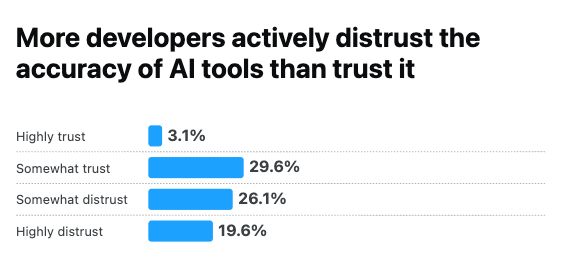- Frictionless, by Pagepro
- Posts
- Stack Overflow: 84% Devs Use AI, but Only 29% Trust It
Stack Overflow: 84% Devs Use AI, but Only 29% Trust It
Inside: Popular npm Hacked and Alibaba vs Google & OpenAI

Hello!
OpenAI is thinking about school already. They’ve introduced a new Study Mode, just as Cursor updates to 1.3.
However, we’re getting more signals that devs are getting frustrated with AI. The latest Stack Overflow Developer survey shows that trust in AI tools fell to a low 29%, even though 84% if devs use them.
MIT released research showing how ChatGPT is affecting our brains, and Anthropic plans to introduce new rate limits in August, despite user protests.
And for something completely different, you can learn how to track airplanes with Grafana!
Grab your coffee and enjoy this issue of Frictionless!
In the Queue
Reduce Friction
Developers Remain Willing but Reluctant to Use AI: The 2025 Developer Survey Results
80% of developers are experimenting with AI tools, but trust in it fell from 40% to 29% this year. Stack Overflow’s reveals a reason behind this growing divide: debugging. That’s only one insight from the survey, so if you’re curious how many devs use agents or are happy at work, read the results.
Software Architecture Is Finally Fixing Its Biggest Problem: Developer Experience
Treating architecture like a product, and not only a backend concern, pays off big time. Modern teams at top companies are taking DX into account when designing systems and see serious productivity gains.
How to Work with AI: Using AI as a Thought Partner
Are you using AI effectively? Having it only execute tasks is a waste of potential. After all, it can be the perfect collaborator to you and your dev team, who will sharpen your thinking and open up new perspectives… provided you’re not overrelying on it.
🎥 How Vercel Saves Dev Teams $10M+ in Productivity Gains
Don’t miss this interview with Guillermo Rauch, the CEO of Vercel. Inside, Guillermo goes over how his mindset helped Next.js take off and turn Vercel into the empire that it is today. You’ll leave with sharp insight into product thinking and how to support developer speed.
Deepen Your Expertise
How npm Package with 30 Million Downloads Spread Malware
One of the most trusted packages in the JavaScript ecosystem, eslint-config-prettier, was hijacked and used to steal developer tokens. A rogue actor slipped through weak 2FA and npm’s verification loopholes, turning a routine dev tool into a credential-harvesting trap.
How Cursor Serves Billions of AI Code Completions Every Day
Have you ever thought what it takes to deliver 1+ million queries per second on AI code suggestions? Look under the hood of Cursor’s infra and learn how it handles fast token streaming, encrypted code isolation, and cross-cloud failover. And speaking of Cursor…
Cursor 1.3 Is Here
Cursor's new update now allows agents to operate directly in shared terminals and edit up to 25% faster! Have you tried it out yet?
An Engineer's Guide to AI Code Model Evals
Addy Osmani, engineering leader at Google, shares how to evaluate coding models with real-world reliability. His guide covers golden tests, eval automation, and avoiding overfitting traps, so give it a read if you’re trying to improve your own AI workflows.
Contentful Migration in 2025: What are the Alternatives?
React components shouldn’t take over 500 lines, but that was our client’s reality with Contentful. If you, too, are struggling with its complexity or rising costs, I’ve prepared a list of Contentful alternatives, which will make your team (and wallet) happy.
AI Corner
Your Brain on ChatGPT - MIT Study
MIT researchers used brain scans to see how ChatGPT affects our thinking. Participants not only had trouble recalling what they wrote with AI’s help, but also had their brain connectivity drop by 47%, from 79 to 42 points.
Alibaba’s Qwen Tops OpenAI & Gemini
Alibaba's Qwen3 model is beating GPT-4 and Gemini 2.5 on core reasoning tests, all while being open source. Google and OpenAI might want to watch their back for now, but will Qwen3 hold up against the upcoming GPT-5?
Anthropic Unveils New Rate Limits to Curb Claude Code Power Users
Anthropic is preparing to introduce new weekly rate limits for Claude Pro and Max. The claims that this is caused by “fans running Claude continuously in the background, 24/7” met with sharp criticism and accusations.
OpenAI Announces New ‘Study Mode’ Product for Students
ChatGPT might join the list of student essentials this year. Study Mode is OpenAI’s latest attempt at structured usage. It's a prompt-guided assistant built for learning, but it might come in handy for more than just school chores.
Just Cool
Tracking Planes With Grafana in Real Time: How to Visualize the Aircraft Overhead with Your Own Dashboard
Yes, Grafana can track planes overhead in real time, and no, it’s not just a gimmick. If you love airplanes, learn how to set up a tracking system using open aviation data and live dashboarding.
Let’s Stay in Touch! 📨
Do you have any comments about this newsletter issue or questions you want to ask? Drop me a message or book a meeting.
What do you think of today's email?Your feedback helps me improve Frictionless. |






